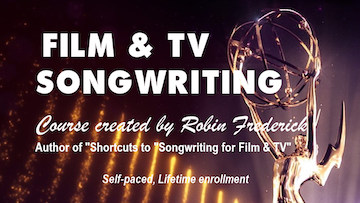
Thousands of songs are used in film and television each year including prime time TV shows, top grossing movies, and commercials. There are usually forty to fifty TV shows using songs and dozens of commercials. For every song that’s placed, many are auditioned—often hundreds—but only one is chosen. The song that will get the job is the one that enhances the emotion or adds impact for viewers. Is a character discovering real love for the first time? The song needs to evoke that feeling for the audience. Is the film set in a small town in the 1950s? The song must vividly and accurately recall the era. Always remember: the song serves the needs of the project.
With that in mind, it may seem strange that a majority of the songs that are placed in film and TV are written and recorded first, then pitched to these projects. Often, the songs are part of an artist’s or band’s CD. While they’re being written, there’s no way to know how these songs will eventually be used in a film or TV show. So, if you don’t know how your song will be used, how can you craft it to increase your chances of a placement?
Film & TV Tip #1: Keep Your Lyric Universal
Music users in the film and TV market often say they’re looking for songs with “universal lyrics.” But just what does that mean?
A universal lyric is…
A lyric that a large number of people can identify with or relate to.
A lyric that will not conflict with the specific content of a scene.
A good lyric for film and TV is universal enough to allow the song to be used in a variety of scenes while still maintaining integrity, originality, and focus. Of course, no song will work for every scene but some themes and situations occur more frequently than others – falling in love, breaking up, or overcoming adversity, for example. If you choose one of these, you’re more likely to be successful. Watch a few TV episodes and look for common themes. Chances are you’re already using some of them in your songs.
Imagery, emotional detail, and a fresh approach to your theme will all add muscle to a universal lyric, making it more appealing to film and TV. On the other hand, too many specific physical details, like place names, proper names, and dates, will limit the uses because they may conflict with the details in the scene itself. If your song is called “I Love You, Sheila” it could be confusing to viewers if there’s no character named Sheila in the scene.
Find out more about adding emotion to your lyric with vivid images.

Film & TV Tip #2: Express Mood & Energy
Filmmakers have always used instrumental music to communicate mood, energy, and atmosphere to the audience, from soaring love themes to the high anxiety of a fast-paced action cue. As songs have grown in popularity with viewers, they’re being used to replace some of that instrumental music. A song that works well for film and TV is one that, like an instrumental cue, uses melody, chords, pace, and rhythm to evoke a single mood or energy level.
If you’ve written an uptempo song about a wild party or a slow song about lost love, you’re already using tempo (pace) and rhythm to express energy or mood. Songwriters often do this instinctively, but you can hone that ability for the film and TV market, making your music even more expressive and useable. Like a film composer, you can choose a tempo and groove that physically express the energy level you want, then back it up with chords melody, and lyrics.
Take a cue from composers.
Remember that songs are often used in place of instrumental underscore, so it’s a good idea to listen to the instrumental cues that accompany various types of scenes: action, danger, romantic meeting or breakup, characters having fun, arguing, or being thoughtful. Notice how the music adds to the effectiveness of scene. Try writing a song that could do the same.


Film & TV Tip #3: Make an Instrumental Mix
While you’re arranging and recording your song, you’re creating something more, something that can provide many additional pitching opportunities for you and earn extra income. It’s a “song bed,” also known as a track-only mix, instrumental mix, or TV mix. Your song’s instrumental track, minus the vocal, is a stand-alone piece of music that can be in scenes, commercials, promo spots, and trailers.
Television uses millions of pieces of instrumental background music, or “cues,” each year. While feature films have a music budget that allows instrumental music to be written expressly for a scene, many television shows and networks rely on music libraries to fill their needs. These music users need everything from powerhouse Rock instrumentals to intimate, solo piano pieces. The track you created to accompany your song can be edited, rearranged, stripped down, and remixed to fill the needs of this market.
Once you have your song bed, you can create instrumental cues of different lengths, add or mute instruments to vary the texture and dynamics, or replace the lead vocal with an instrument.
How to make a song bed.
The easiest way to create a track-only mix is to mute all the vocals, including any vocal doubles, harmonies, and background parts, then run your mix. If you still hear a “ghost” of the vocal, check to see that all the vocal effects, like reverb and delay, are muted.
Create a button ending: While you’re working on your track, spend a few extra minutes on the ending. Make certain your track has a clear, well-defined end point. Avoid long instrumental fade-outs. Instead, use a chord or riff with a clean finish (all instruments end at the same time).
No sound effects in your mix: If you include the sound of ocean waves in your track, you limit its uses. Put it in a desert scene? No way. When creating a song bed, remove all sound effects such as crowd noise, nature sounds, car horns, or laughter, anything that might conflict with the content of a scene and distract the viewer.
Have a “track-only” mix ready to go.
If you recorded and mixed your song in your own studio, run an instrumental mix immediately after your final vocal mix. That way, you can be certain that the two mixes are identical in every way except the vocal.
If you’re working in a commercial studio or using a demo production service, be sure to ask them for a track-only mix. They should be happy to do this for you. There may be a small extra charge but it’s well worth the money. If you’re able to do some editing on your home computer, you can ask for various sub-mixes (or “stems”) that will allow you plenty of editing flexibility at home.
Don’t keep them waiting: When your song is placed, the music supervisor will ask for your instrumental mix. Why? Because it can be used to adapt your song to the demands of a scene, replacing a portion of the vocal with the instrumental to avoid conflicts with dialogue, looping it to extend the song, or adding a few seconds to make certain a lyric line falls in the right place. A music library will ask for a track-only mix when they make a deal for your song. You don’t want to find yourself saying, “Gee, I haven’t got one.” Or “I’ll see what I can do.” Be ready to rock ‘n’ roll. Get your instrumental mix done ahead of time, have it clearly labeled, and ready to go out the door.
Writing Songs for TV Commercials
Basic Broadcast Quality for Film & TV (on MySongCoach.com)
Raw Sound for a Slick TV Commercial (on MySongCoach.com)
